Platonic solid
The platonic solids (named after the Greek philosopher Plato) are a family of five convex polyhedra which exhibit a particularly high symmetry. They can be characterized by the following two properties: All its sides (faces) are regular polygons and congruent to each other, and the same number of sides meet in all its corners (vertices). However, they also satisfy the following much stronger symmetry condition: Each flag, i.e. each sequence consisting of a corner of an edge of a face, "looks the same". i.e., cannot be distinguished from the others by its position on the polyhedron. Because of this latter property they are called regular polyhedra.
The Greek names of the platonic solids are derived from the number of sides:
- Tetrahedron: 4 equilateral triangles, 4 corners in which 3 sides meet
- Hexahedron (or cube): 6 squares, 8 corners in which 3 sides meet
- Octahedron: 8 equilateral triangles, 6 corners in which 4 sides meet
- Dodecahedron: 12 regular pentagons, 20 corners in which 3 sides meet
- Icosahedron: 20 equilateral triangles, 12 corners in which 5 sides meet
Enumeration
It is easy to see that there are at most five Platonic solids:
The corner of a convex polyhedron is formed by three or more sides, and the sum of the angles cannot exceed 2π.
- Therefore there are only five possibilities: 3, 4, or 5 triangles (angle π/3), 3 squares (angle π/2), and 3 pentagons (angle 3π/5), corresponding to tetrahedron, octahedron, icosahedron, cube, and dodecahedron, respectively.
Of these five possibilities three obviously give polyhedra with the desired properties. For the dodecahedron and the icosahedron, however, additional arguments are needed.
- 6 triangles, 4 squares, and 3 hexagons (angle 2π/3) are special because in these three cases the sum of the angles is 2π, and they give the regular tilings of the plane.
- For n>6, the angle for the regular n-gon is (n-2)π/n, and the sum of three angles is (3-6/n)π and thus is always greater than 2π. Therefore there are no corresponding solids.
- There are two polyhedra with equilateral triangles as sides, a 3-sided and a 5-sided double-pyramid. But they are not Platonic solids since there meet 4 triangles at the base corners, but 3, respectively 5, triangles at the tops of the pyramids.
Duality
The midpoints of the sides of a Platonic sides - the corners of the dual polyhedron - is also a Platonic solid:
- The cube and the octahedron are dual to each other.
- The dodecahedron and the icosahedron are dual to each other.
- The tetrahedron is dual to itself.
Table
| number of faces |
name | type of face | volume | surface area |
properties | image |
|---|---|---|---|---|---|---|
| 4 | regular tetrahedron (or regular triangular pyramid) |
equilateral triangle | 4 vertices, 6 edges, self-dual | 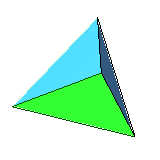
| ||
| 6 | cube | square | 8 vertices, 12 edges, dual to octahedron | 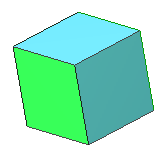
| ||
| 8 | regular octahedron | equilateral triangle | 6 vertices, 12 edges, dual to cube | 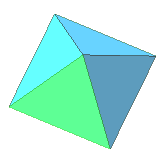
| ||
| 12 | regular dodecahedron | regular pentagon | 20 vertices, 30 edges, dual to icosahedron | 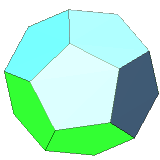
| ||
| 20 | regular icosahedron | equilateral triangle | 12 vertices, 30 edges, dual to dodecahedron | 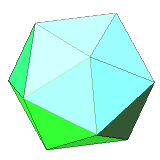
|
A sphere circumscribed about any of the Platonic solids will touch all the vertices, and a sphere inscribed within any will touch all the faces at the center of the face.









